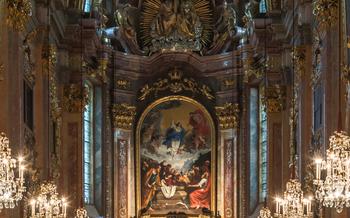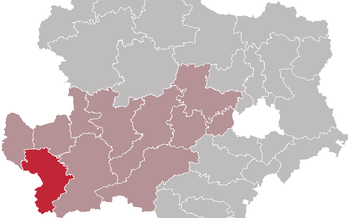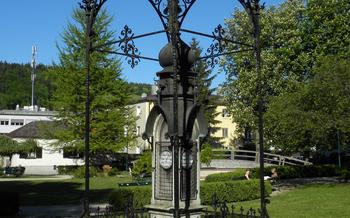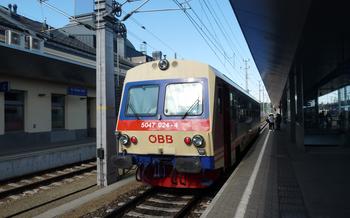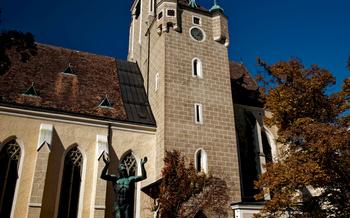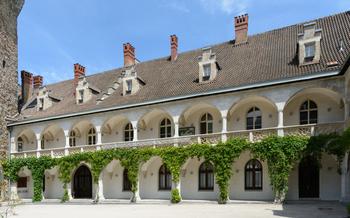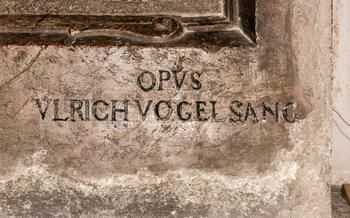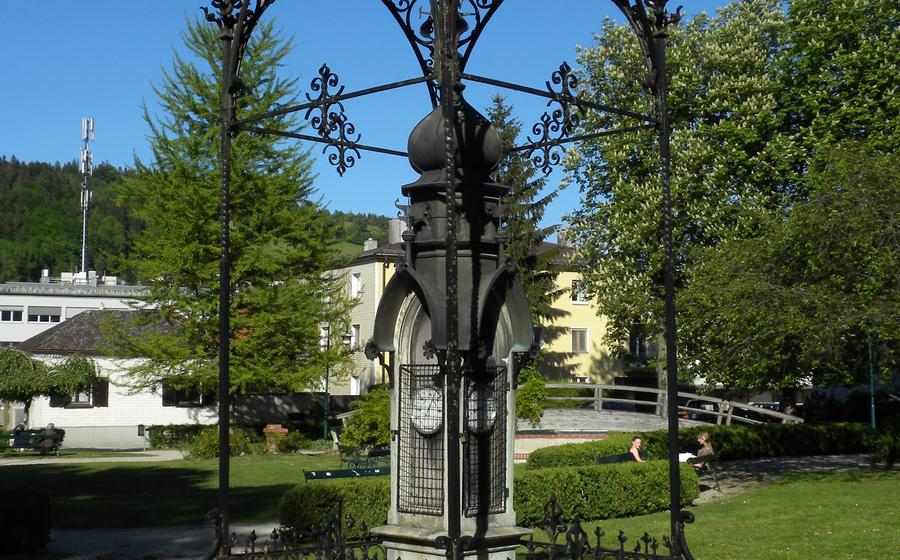
Pfarrkirche St. Stephan
- Waidhofen an der Ybbs and the Pfarrkirche St. Stephan
- Location and Accessibility
- Visiting Hours and Admission Fees
- Highlights of the Church Interior
- Historical Significance
- Architectural Style and Features
- The Altar
- The Pulpit
- Stained Glass Windows
- Organ and Music
- Local Traditions and Customs
- Photography and Videography
- Accessibility for Visitors with Disabilities
- Nearby Restaurants and Cafes
- Insider Tip: A Hidden Gem and a Unique Experience
Waidhofen an der Ybbs and the Pfarrkirche St. Stephan
Waidhofen an der Ybbs, a charming town nestled amidst the picturesque landscape of Lower Austria, boasts a rich history dating back to the Middle Ages. The town's strategic location along the Ybbs River made it a significant trading center, and its prosperity is reflected in its well-preserved medieval architecture. Among the town's architectural gems is the Pfarrkirche St. Stephan, a stunning Gothic masterpiece that stands as a testament to the town's religious and cultural heritage.
The Pfarrkirche St. Stephan, also known as the Parish Church of St. Stephen, was constructed in the 14th century and consecrated in 1360. Built in the Late Gothic style, the church exhibits a harmonious blend of architectural elements, including pointed arches, ribbed vaults, and intricate stone carvings. Its imposing facade, adorned with delicate tracery and sculptures, hints at the grandeur that awaits visitors within.
The church's interior is equally impressive, showcasing a spacious nave with towering pillars and a magnificent ribbed vault ceiling. The walls are adorned with vibrant frescoes depicting biblical scenes and the lives of saints, adding to the church's sacred atmosphere. The Pfarrkirche St. Stephan is a testament to the skill and artistry of medieval craftsmen and stands as a cherished symbol of Waidhofen an der Ybbs' rich cultural and religious heritage. Its designation as a protected historical monument underscores its significance as a national treasure.
Location and Accessibility
The Pfarrkirche St. Stephan is conveniently situated at Kirchenplatz 1, 3340 Waidhofen an der Ybbs, Austria. Public transportation offers an accessible option for visitors, with the nearest bus stop, Waidhofen/Ybbs Busbahnhof, just a short walk away. The church's central location in the city heart allows for easy exploration on foot, inviting visitors to delve into the charming streets and discover other notable landmarks in the vicinity. Whether arriving by public transport or private vehicle, the Pfarrkirche St. Stephan welcomes visitors to immerse themselves in its rich history and architectural grandeur.
Visiting Hours and Admission Fees
The doors of the majestic Pfarrkirche St. Stephan are open to the public throughout the week, inviting visitors to step into its sacred space and immerse themselves in its architectural grandeur. While admission to the church is free of charge, allowing all to experience its beauty without hindrance, it's essential to be mindful of the designated visiting hours.
From Monday to Thursday, the church welcomes visitors between 8 am and 6 pm, providing ample opportunity to explore its intricate details and soak in the serene atmosphere. On Friday, the hours are slightly shorter, with the church open from 8 am to 12 pm, allowing visitors to plan their visit accordingly.
It's worth noting that the church may occasionally host special events or services that may affect the regular visiting hours. To avoid any inconvenience, it's advisable to check the church's website or contact the local parish office in advance to confirm the exact visiting times.
Whether seeking a moment of spiritual reflection, admiring the architectural masterpiece, or simply exploring the town's rich heritage, the Pfarrkirche St. Stephan stands as a welcoming beacon, inviting all to step inside and experience its timeless allure.
Highlights of the Church Interior
The interior of the Pfarrkirche St. Stephan is a testament to the grandeur and artistry of Gothic architecture. The church boasts a spacious and awe-inspiring nave, with intricate rib vaults that soar upwards, creating a sense of height and majesty. The walls are adorned with vibrant frescoes depicting scenes from the Bible, adding a touch of color and storytelling to the sacred space.
One of the most striking features of the church's interior is its collection of stained glass windows. These magnificent windows, meticulously crafted by skilled artisans, depict biblical scenes and figures in vibrant hues. The windows cast a warm and colorful glow into the church, creating an ethereal atmosphere that invites contemplation and reverence.
The high altar, a masterpiece of craftsmanship, is another highlight of the church's interior. Intricately carved and adorned with gold leaf, the altar features a central panel depicting the crucifixion of Jesus Christ, flanked by statues of saints and apostles. The altar serves as a focal point for worship and devotion, drawing the eyes of visitors and inspiring a sense of awe.
Among other notable features of the church's interior are the elaborately carved pulpit, adorned with intricate reliefs and allegorical figures; the baptismal font, a work of art in its own right; and the impressive organ, with its gilded pipes and ornate carvings. The harmonious blend of these elements creates a cohesive and visually stunning interior space that is sure to leave visitors in awe.
Historical Significance
The Pfarrkirche St. Stephan holds a significant place in the history of Waidhofen an der Ybbs, having served as a spiritual and communal hub for centuries. Its origins can be traced back to the 12th century, when a Romanesque church stood on the same site. Over time, the church underwent several renovations and expansions, reflecting the town's growing prosperity and the evolving needs of the congregation.
Throughout its history, the Pfarrkirche St. Stephan has witnessed numerous important events and played a pivotal role in the lives of Waidhofen's residents. It has served as a place of worship, a gathering place for religious festivals and celebrations, and a refuge during times of crisis. The church has also been a silent observer of the town's transformation, from a small medieval settlement to a thriving industrial center.
In recognition of its historical and cultural significance, the Pfarrkirche St. Stephan was designated as a protected historical monument in 192This designation ensures that the church's unique architectural features and its role in Waidhofen's history are preserved for future generations.
Architectural Style and Features
The Pfarrkirche St. Stephan in Waidhofen an der Ybbs represents a harmonious blend of various architectural influences, reflecting the changing tastes and trends of different eras. Its core structure showcases the Late Romanesque style, characterized by its rounded arches, thick walls, and robust proportions. This style, prevalent in the 12th and 13th centuries, emphasized solidity and simplicity, creating a sense of awe and reverence within the sacred space.
In the 15th century, the church underwent significant renovations, infusing elements of the Gothic style, known for its soaring heights, intricate details, and ornate embellishments. The addition of pointed arches, ribbed vaults, and delicate tracery transformed the interior, infusing it with a sense of lightness and elegance. The ribbed vaults, in particular, showcase the Gothic style's emphasis on structural ingenuity, allowing for larger and more open spaces while maintaining structural integrity.
During the Baroque period, the church underwent further embellishments, embracing the exuberant and ornate style that characterized the era. Decorative stuccowork, elaborate frescoes, and gilded accents adorned the interior, creating a visually stunning and opulent space. The Baroque additions harmoniously blend with the existing Romanesque and Gothic elements, resulting in a rich and layered architectural tapestry that reflects the passage of time and the evolution of artistic styles.
The Altar
The altar of the Pfarrkirche St. Stephan is a masterpiece of Baroque art, crafted from the finest marble and adorned with intricate carvings and gilding. Its central feature is a stunning altarpiece depicting the martyrdom of St. Stephen, the church's patron saint. The altarpiece, a work of the renowned Austrian artist Martin Johann Schmidt, is a testament to the church's rich artistic heritage.
The altar's design is a testament to the Baroque era's love of grandeur and opulence. Its sweeping curves and elaborate ornamentation create a sense of awe and wonder. The altar is framed by six twisted columns, each adorned with delicate carvings of acanthus leaves and flowers. The columns support a broken pediment, a symbol of St. Stephen's martyrdom.
The altarpiece is a masterpiece of storytelling, capturing the drama and emotion of St. Stephen's final moments. The central figure of St. Stephen, his eyes turned heavenward, exudes a sense of serenity and faith amidst the chaos surrounding him. The surrounding figures, their faces contorted in expressions of anger and violence, underscore the brutality of St. Stephen's persecution.
The symbolism of the altar is rich and multifaceted. The white marble symbolizes purity and innocence, while the gold leaf represents divine glory. The carvings of acanthus leaves and flowers represent the eternal cycle of life and renewal. The broken pediment is a reminder of St. Stephen's martyrdom, but it also symbolizes the triumph of faith over adversity.
The altar of the Pfarrkirche St. Stephan is a true work of art, a testament to the skill and devotion of the craftsmen who created it. It is a focal point of the church's interior, inviting visitors to contemplate the life and sacrifice of St. Stephen and to reflect on the power of faith.
The Pulpit
The pulpit of the Pfarrkirche St. Stephan is a magnificent work of art that commands attention with its intricate carvings and ornate design. Crafted from fine wood and adorned with delicate details, the pulpit stands as a testament to the skill and artistry of its creators. Its elevated position within the church symbolizes the authority and importance of the spoken word, as it was from here that priests and religious leaders delivered their sermons and teachings to the congregation.
The pulpit's design features a hexagonal base adorned with intricate carvings depicting biblical scenes and figures. Each panel showcases a unique narrative, inviting viewers to contemplate the stories and lessons they hold. The intricate details and symbolism in these carvings add depth and meaning to the pulpit's overall aesthetic.
The staircase leading up to the pulpit is adorned with ornate railings and delicate spindles, creating a sense of grandeur and elegance. The pulpit's canopy, supported by slender columns, is a masterpiece in itself, featuring intricate carvings and delicate tracery work. The intricate craftsmanship of the canopy provides a fitting backdrop for the pulpit, emphasizing its significance as a focal point within the church.
Stained Glass Windows
The Pfarrkirche St. Stephan is renowned for its magnificent stained glass windows, which adorn the church's interior with vibrant colors and intricate designs. These windows, crafted by skilled artisans, depict a variety of biblical scenes and stories, adding a spiritual and artistic dimension to the church's atmosphere.
The windows feature a diverse range of subjects, including scenes from the life of Jesus Christ, such as his birth, crucifixion, and resurrection. Other windows depict moments from the Old Testament, such as the creation of the world and the story of Noah's Ark. The windows' vibrant hues and intricate details bring these biblical narratives to life, creating a sense of awe and inspiration for visitors.
One of the most notable stained glass windows in the church is the "Last Supper" window, which depicts Jesus sharing his final meal with his disciples. The window's vivid colors and lifelike figures capture the emotion and significance of this pivotal moment in Christian history.
The stained glass windows of the Pfarrkirche St. Stephan are not only beautiful works of art but also serve as powerful teaching tools, illustrating biblical stories and conveying religious messages to the faithful. They add to the church's rich spiritual heritage and contribute to its unique and captivating atmosphere.
Organ and Music
The Pfarrkirche St. Stephan is home to a magnificent organ, a remarkable instrument that has been an integral part of the church's musical heritage for centuries. Built by the renowned organ builder Matthäus Mauracher in 1755, this Baroque masterpiece boasts 23 stops, two manuals, and a pedalboard, showcasing the grandeur and complexity of its sound. The organ's intricate carvings and gilded embellishments further enhance its visual appeal, making it a true work of art.
Throughout history, the organ has played a pivotal role in the church's musical life, accompanying countless religious services, weddings, funerals, and special occasions. Its rich and resonant tones have filled the sacred space, creating an atmosphere of awe and inspiration for generations of worshippers. The organ has also been featured in numerous concerts and recitals, showcasing the talents of renowned organists and delighting music enthusiasts far and wide.
One notable organist associated with the Pfarrkirche St. Stephan is Anton Bruckner, a renowned Austrian composer and organist who served as the church's organist from 1855 to 186Bruckner's mastery of the organ and his deep understanding of its capabilities are evident in his compositions, which often feature intricate organ parts that showcase the instrument's versatility and expressive power.
If you happen to visit the Pfarrkirche St. Stephan during a religious service or a special musical event, be sure to take a moment to appreciate the magnificent sounds of the organ. Its rich tones and harmonious melodies will transport you to a realm of spiritual and musical transcendence, leaving an unforgettable impression on your visit to this historic church.
Local Traditions and Customs
The Pfarrkirche St. Stephan is deeply ingrained in the cultural fabric of Waidhofen an der Ybbs and serves as a focal point for various local traditions and customs. One notable tradition is the annual "Kirchtag," a lively festival held on the Sunday closest to September 8th, the feast day of St. Stephan. The Kirchtag features a festive mass followed by a colorful procession through the town, accompanied by traditional music and costumes. Locals and visitors alike gather to celebrate, enjoy traditional food and beverages, and participate in various games and activities. The Kirchtag is a vibrant expression of the community's deep connection to the church and its patron saint.
Furthermore, the church plays a significant role in the community's religious life. Regular masses, baptisms, weddings, and other religious ceremonies take place within its sacred walls. During the Christmas season, the church is adorned with festive decorations, and special Christmas masses are held to celebrate the birth of Jesus Christ. These events bring the community together, fostering a sense of unity and spiritual connection. The Pfarrkirche St. Stephan stands as a testament to the enduring traditions and customs that have shaped the identity of Waidhofen an der Ybbs over the centuries.
Photography and Videography
Photography and videography are generally allowed inside the Pfarrkirche St. Stephan, providing a great opportunity to capture the church's beauty and grandeur. However, it's important to be respectful of the sacred nature of the space and to avoid disturbing any ongoing services or ceremonies. Using a flash or tripod may be restricted, so it's best to check with the church staff before using any additional equipment.
For the best photography results, try to visit the church during the daytime when natural light is most abundant. The colorful stained glass windows are particularly stunning when illuminated by the sun, casting a warm glow throughout the interior. To capture the full majesty of the church's architecture, consider using a wide-angle lens to take shots from different perspectives.
If you're interested in videography, be sure to plan your shots carefully to minimize any disruption to other visitors. Consider using a silent recording mode if available, and be mindful of the acoustics when capturing audio. Editing your footage later can help you create a beautiful and immersive video that showcases the unique atmosphere of the Pfarrkirche St. Stephan.
Accessibility for Visitors with Disabilities
The Pfarrkirche St. Stephan is committed to ensuring that all visitors, regardless of their abilities, can enjoy and appreciate the church. The church is wheelchair accessible, with ramps and elevators available to reach all levels of the building. Designated areas and seating are also available for visitors with disabilities, ensuring that they can fully participate in services and events. The church's staff is friendly and accommodating, and they are always willing to assist visitors with any needs they may have. Whether you are a person with a disability or simply looking for a more accessible way to experience the church, the Pfarrkirche St. Stephan is a welcoming and inclusive space for all.
Nearby Restaurants and Cafes
After a captivating visit to the Pfarrkirche St. Stephan, consider indulging in the culinary delights offered by the charming establishments in the vicinity. For a quick bite, head to the cozy Café-Konditorei Kern, a local favorite renowned for its delectable pastries and aromatic coffee. For a more substantial meal, try Gasthof Kirchenwirt, a traditional Austrian restaurant serving hearty dishes prepared with fresh, local ingredients. If you're seeking a unique dining experience, reserve a table at Schlosswirt Waidhofen, an elegant restaurant housed within a historic castle, offering stunning views and a refined menu. No matter your preference, the area surrounding the Pfarrkirche St. Stephan promises a satisfying culinary adventure.
Insider Tip: A Hidden Gem and a Unique Experience
For a truly special and unforgettable experience, time your visit to the Pfarrkirche St. Stephan to coincide with one of the church's regular organ concerts. These concerts showcase the talents of world-renowned organists and feature a repertoire of classical and contemporary pieces that fill the church with their majestic sounds. Immerse yourself in the divine music and let the enchanting melodies transport you to another realm, creating a truly awe-inspiring and spiritual moment.
